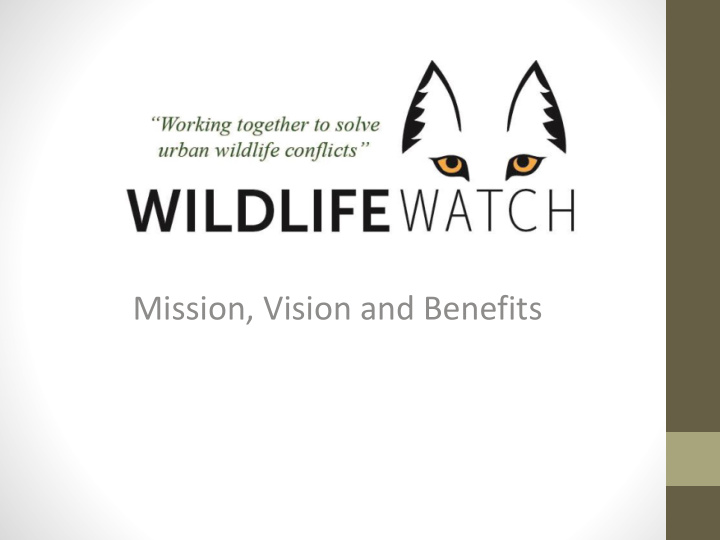



Mission, Vision and Benefits
Mission Statement The mission of Wildlife Watch is to establish a comprehensive, integrated management strategy for minimizing human-wildlife conflicts and improving the quality of life in urban settings. The approach applies conservation and ecological principles, agency and community leadership and respect for wildlife and one another.
Vision Statement • To empower people to respect wildlife through the understanding of ecology and conservation principles. • To reduce wildlife conflict while improving the quality of life. • To promote a T-E-A-M environment based on Trust, Encouragement, Accountability and Modeling by collaborating interdependently rather than by competing independently. • To teach conservation and ecological principles based on facts not feelings, seeking first to understand and then be understood.
Vision Statement (continued) • To develop a network of relationships between communities and agencies entrusted to manage and protect our wildlife resources and its people, demonstrating effective stewardship. • To value and respect each other’s differences regarding how to respond to and manage wildlife conflicts. • To encourage empathy and compassion for those who have lost pets or who feel threatened by urban wildlife, paying attention and listening to understand the speaker’s words, intent and feelings.
Vision Statement (continued) • To recognize that entitlement and anthropomorphism (putting human traits on animals) has changed how we relate to our wildlife resources in the urban environment. • To implement a train-the-trainer teaching approach allowing the public and agencies to share information through integrated communication. • To develop a first-of-its-kind program in California that is used as a model nationwide.
Benefits • Improved quality of life in urban areas. • Reduction in public safety incidents as well as property and pet loss. • Saves agency time, resources and money. • Promotes better communication between agencies and the communities they serve. • Supports consistency in agency response through effective collaboration and coordination.
Benefits (continued) • Creates increased awareness of urban wildlife, reducing complacency while promoting education at all age levels. • Community conservation coaches become the eyes and ears of agency personnel, municipalities and public officials. Trained to observe and report, they increase field and administrative time for paid staff allowing them to stay focused on higher priority assignments. • Coaches are empowered by their ability to give back their talents to the community, not by the position they are entrusted with.
Recommend
More recommend